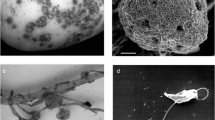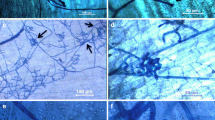Abstract
Root galls possibly caused by Spongospora subterranea were observed on hairy nightshade (Solanum sarrachoide; HNS). HNS galls and galls from potato were used to artificially inoculate potato and HNS. Eighty-three and 52% potato and HNS plants inoculated with potato inoculum had root galls, respectively. Ten and 31% potato and HNS plants inoculated with HNS inoculum had root galls, respectively. A S. subterranea-specific PCR significantly correlated (P < 0.0001, Phi Coefficient = 0.69) with visual assessment of gall incidence in 34 of 40 samples. Five of 40 samples had no galls, but gave positive PCRs. One of 40 samples had root galls, but gave a negative PCR. More sporosori were produced on potato than on HNS. Therefore, the root galls on HNS were caused by S. subterranea that is able to complete its life cycle on HNS and produce new generations of sporosori that are infectious on potato.
Resumen
Agallas de la raíz, posiblemente causadas por Spongospora subterranea fueron observadas en belladona vellosa (Solanum sarrachoide; HNS). Agallas de HNS y de papa fueron utilizadas para inocular artificialmente papa y HNS. El 83% y el 52% de plantas de papa y HNS inoculadas con inóculo de papa tuvieron agallas de la raíz respectivamente. El 10% y 31% de plantas de papa y HNS inoculadas con inóculo de HNS tuvieron agallas de la raíz respectivamente. Un PCR especifico para S. subterranea correlacionó significativamente (P < 0.0001, Coeficiente Phi = 0.69) con evaluación visual de incidencia de agallas en 34 de 40 muestras. Cinco de 40 muestras no tuvieron agallas pero dieron PCR positivo. Una de las 40 muestras tuvo agallas de la raíz pero dio PCR negativo. Más sporosori fue producido en papa que en HNS. Por lo tanto las agallas de la raíz en HNS fueron causadas por S. subterranea que es capaz de completar su ciclo de vida en HNS y producir nuevas generaciones de sporosori que son infecciosas en papa.




Similar content being viewed by others
References
Alexopoulos, C.J., C.W. Mims, and M. Blackwell. 1996. Phylum Plasmodiophoromycota. Endoparasitic slime molds. In Introductory Mycology, 4th ed., 751–758. John Wiley & Sons, Inc.
Andersen, B.A.B., M. Nicolaisen, and S.L. Nielsen. 2002. Alternative hosts for potato mop-top virus, genus Pomovirus and its vector Spongospora subterranea f.sp. subterranea. Potato Research 45: 37–43.
Alvarez, J.M., and R. Sinivasan. 2005. Evaluation of hairy nightshade as an inoculum source for aphid-mediated transmission of potato leafroll virus. Journal of Economic Entomology 98: 1101–1108.
Alvarez, J.M., and P.J.S. Hutchinson. 2005. Hairy nightshade management in potatoes. Managing hairy nightshade to reduce potato viruses and insect vectors. Outlooks on Pest Management. doi:10.1564/16dec03.
Brown, C.R., H. Mojtahedi, S. James, R.G. Novy, and S. Love. 2006. Development and evaluation of potato breeding lines with introgressed resistance to Columbia root-knot nematode (Meloidogyne chitwoodi). American Journal of Potato Research 83: 1–8.
Braselton, J.P. 1995. Current status of the Plasmodiophorids. Critical Reviews in Microbiology 21(4): 263–275.
Braselton, J.P. 2001. Plasmodiphoromycota. In The Mycota VII Part A Systematics and Evolution, ed. D.J. McLaughan, E.G. McLaughlin, and P.A. Lemke, 81–91. Berlin and Heidelberg: Springer-Verlag.
Boydston, R. 2006. Potato disease, nematode, and insect problems worsened by hairy nightshade. In Proceedings of the 45th Washington State Potato Conference, 1–4. Published by the Washington State Potato Commission, www.potatoes.com.
Boydston, R.A., P.J.S. Hutchinson, and R.R. Bellinder. 2008a. Managing weeds. In Potato Health Management, 2nd ed., 223-225. St. Paul: The American Phytopathological Society.
Boydston, R.A., H. Mojtahedi, J.M. Crosslin, C.R. Brown, and T. Anderson. 2008a. Effect of hairy nightshade (Solanum sarrachoides) presence on potato nematode, disease, and insect pests. Weed Science 56: 151–154.
Corliss, J.O. 1994. An interim utilitarian (“user-friendly”) hierarchical classification and characterization of the Protists. Acta Protozoologica 33: 1–51.
Crosslin, J.M., G.J. Vandemark, and J.E. Munyaneza. 2006. Development of a real-time, quantitative PCR for detection of the Columbia Basin potato purple top phytoplasma in plants and beet leafhoppers. Plant Disease 90: 663–667.
Eberlein, C.V., M.J. Guttieri, and W.C. Schaffers. 1992. Hairy nightshade (Solanum sarrachoides) control in potatoes (Solanum tuberosum) with bentazon plus additives. Weed Technol 6: 85–90.
Harrison, B.D., and R.A.C. Jones. 1970. Host range and some properties of potato mop-top virus. Annals of applied Biology 65: 393–402.
Harrison, J.G., R.J. Searle, and N.A. Williams. 1997. Powdery scab of potato—a review. Plant Pathology 46: 1–25.
Jones, R.A.C., and B.D. Harrison. 1969. The behaviour of potato mop top virus in soil, and evidence for its transmission by Spongospora subterranea (Wallr.) Lagerh. Annals of Applied Biology 63: 1–17.
Jones, R.A.C., and B.D. Harrison. 1972. Ecological studies on potato mop-top virus in Scotland. Annals of applied Biology 71: 47–57.
Kole, A.P. 1954. A contribution to the knowledge of Spongospora subterranea (Wallr.) Legerh., the cause of powdery scab of potatoes. Tijdschr Planten 60: 1–65.
Karling, J.S. 1981. Woronina leptolegniae n. sp., a plasmodiophorid parasite of Leptolegnia. Nova Hedwigia 37: 17–24.
Merz, U. 2008. Powdery scab of potato—Occurrence, life cycle and epidemiology. American Journal of Potato Research 85: 241–246.
Ogg, A.G., and B.S. Rogers. 1989. Taxonomy, distribution, biology, and control of black nighshade (Solanum nigrum) and related species in the United States and Canada. Reviews of Weed Science 4: 25–58.
Qu, X., and B.J. Christ. 2006. The host range of Spongospora subterranea f.sp. subterranea in the United States. American Journal of Potato Research 83: 343–347.
Van de Graaf, P., S.J. Wale, and A.K. Lees. 2007. Factors affecting the incidence and severity of Spongospora subterranea infection and galling in potato roots. Plant Pathology 56: 1005–1013.
Zar, J.H. 1996. Biostatistical Analysis, 3rd ed. Published by Prentice Hall. NJ. U.S.A.
Author information
Authors and Affiliations
Corresponding author
Rights and permissions
About this article
Cite this article
Nitzan, N., Boydston, R., Batchelor, D. et al. Hairy Nightshade is an Alternative Host of Spongospora subterranea, the Potato Powdery Scab Pathogen. Am. J. Pot Res 86, 297–303 (2009). https://doi.org/10.1007/s12230-009-9083-1
Received:
Accepted:
Published:
Issue Date:
DOI: https://doi.org/10.1007/s12230-009-9083-1




